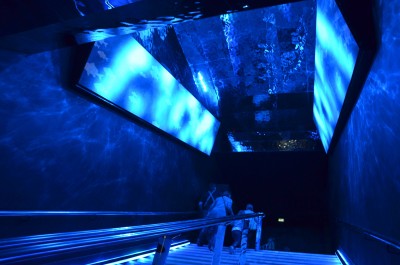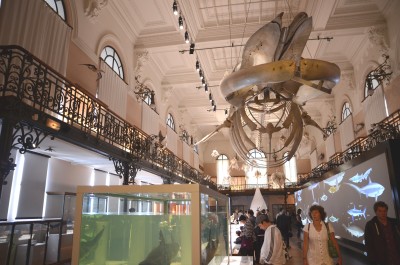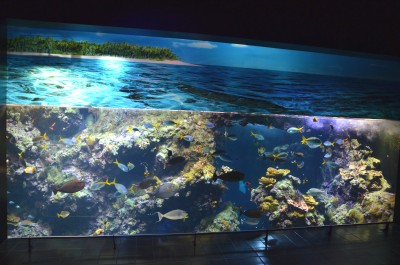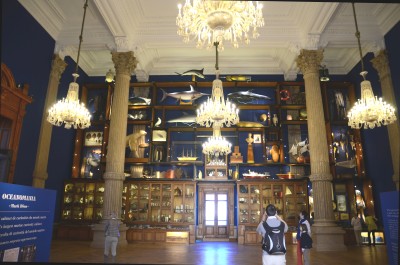On 6500 sqm the Musée Océanographiqe, one of the world’s oldest aquariums, presents more than 6000 specimens in their reconstructed natural habitat.
We visited the museum on 15 April 2014. After a well guided short walk through the historic city of Monaco with great views on the small principality and the tremendous Monte-Carlo, we reached the museum situated directly on the sea, in extension of a cliff. The prices are really moderate for such a stunning and beautiful building, built during the belle-epoche, with a marvelous exterior and interior design.
Blue-darkened hallways which create a great maritime atmosphere led us downstairs to the lower floors where we found the big shark lagoon, containing lots of different species such as blacktip reef sharks, a nurse shark, a hawksbill turtle, moray eels and a giant guitarfish. Further we were guided to the exhibitions of species of the Mediterranean and tropical seas, including several thousand fish specimens, more than 200 species of invertebrates and about one hundred species of hard and soft corals.
Approximately one hundred pools, ranging in size from 100 to 400,000 liters, show the beautiful diversity of the maritime world.
In the upper floors we found different exhibitions, one engaging with sharks and the notable reproduction of sharks and some other maritime species. A big interactive screen, demonstrating sharks (in their real size) and their behaviour, allows the visitor to provoke different animations about several shark species. This unique and playful presentation enhances our understanding of the important role of sharks for the marine ecosystems and also highlights how endangered most of these species are. It’s a forceful lesson for forgetting the Hollywood image of the shark!
A second highlight was a guided tour by a young scientist of the aquarium, Adrien Berne, who gave an overview about the multiple reproduction strategies of the different species represented in the aquarium and the unique research about this fascinating topic. The other part of the exhibition is about the history of maritime research and the connection of humans with the seas.
The museum wants and always wanted to be a place where scientific evidence and enthusiasm for the marine world are transmitted to the public, especially to young people. And they do that very well.




Most of the pools are equipped with a touch screen panel, displaying clearly arranged information about the different species inhabiting the pool in an attractive manner, and all this in four different languages.
In several places, the museum shows the threats to which the seas and oceans are exposed. Among these are the consequences of acidification as one manifestation of climate change and a movie about the massive shark extermination as a result of the huge international trade in sharkfins. Info panels create awareness about the other major threats from human activities to the seas and oceans and, of course, their inhabitants. Overfishing has impoverished ecosystems in all oceans and seas. Marine pollution, particularly through plastic litter, mostly from land-based sources, and overfertilisation from agricultural runoff and untreated industrial and municipal sewage, once at best local nuisances, have become regional if not global problems.
The museum works together with artists from all around the world to connect maritime science and art. The blending of the two can be seen on several floors of the museum. The most attractive is the arrangement “Oceanomania” – a curiosity cabinet arranged by the famous artist Mark Dion.
The Musée Océanographique is particularly committed to the conservation of endangered marine species. It participates in international programmes to protect and reproduce endangered species, like the apogon, a cardinal fish, suffering due to overfishing. For information on threatened fish species by country or major island, check out FishBase, the web platform on all fish species known to science.
The Musée Océanographique really succeeds in inspiring its visitors about the beauty of the seas and how abundant its beautiful inhabitants once were. It also points the attention of the visitors to the problems of the oceans. It explains the urgency of addressing these problems and how important biodiversity is. Thus it sensitises the visitors well about why we need to care for the oceans and how to counter the major threats. This way, it certainly contributes to maritime and ecological education.
We were really delighted about the visit and overwhelmed by the great commitment of the Musée to promote sustainable relations with the seas and oceans. We were particularly impressed by its educational work. The aquarium and the special exhibitions are definitely worth a visit!
A visit of the informative website helps you prepare even better.
by Leo Jering
